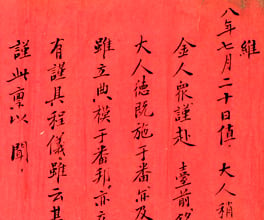Chinese
There were Chinese in Victoria before the gold rushes: merchants in Melbourne and domestic and farm labourers throughout the state. But like their European counterparts, the lure of gold brought many thousands more once news of Victoria’s riches spread through the shipping routes and newspapers.
In and around what is now Guangdong province in southern China, where 90% of Chinese miners came from, civil war had disrupted farming practices and made life unsafe for many villagers. Lum Khen Yang - later a successful merchant in Melbourne - describes the situation in Taishin:
Our money and property were plundered, we had not the means of purchasing a morsel to put into our mouths and there appeared no way by which we could extricate ourselves from poverty […] We happily heard intelligence regarding a new gold-field in an English colony. We were told that men from all parts of the world were congregated there [...] that the people were peaceably disposed, and that the country abounded in everything. The idea of going to such a country was delightful [...] I then made an effort to get as much money as would pay my passage to this productive country.
- Lum Khen Yang
Lum Khen Yang in The Wesleyan Chronicle, 1 Feb 1859 quoted in Colonial casualties: Chinese in early Victoria, Melbourne University Press, Melbourne, Vic.
Numbers of Chinese visitors peaked in 1858 at around 30,000. They were almost all young men and they represented 10% of the male population of the colony.
The fear of an 'invasion' from China was often expressed in Melbourne newspapers and this fear probably motivated much of the ill-feeling towards the Chinese. The predominance of men among the arrivals and the different cultural and religious practices of the Chinese marked them as different, even 'barbaric' to the colonists who were mainly Christian and of European descent. As historian Kathryn Cronin states from her survey of newspapers of the time: 'Even the simplest daily tasks of Chinese assumed a sinister aspect.'
Conflicts quickly arose. It was common for Chinese to be driven from claims that had proven to be rich in gold. They were often pushed to new areas or forced to work abandoned sites.
Joseph Panton, the commissioner of the Bendigo goldfields used police to guard Chinese camps and threatened diggers with arrest should they take any violent action. Panton proposed the establishment of Chinese Protectorates, like the Aboriginal Protectorate. The Chinese population elected ‘headmen’ as their leaders, and special Chinese constables and interpreters were placed on the government payroll. While the system segregated communities and caused problems of its own, it did guarantee some basic rights to the Chinese and allowed them better access to the legal system.
In 1857, Buckland River was the site of Victoria’s worst violence against the Chinese population. A band of 30 or 40 miners drove Chinese miners from their claims burning 750 tents and 30 stores. Four Chinese miners were either beaten to death or drowned in the icy waters of the Buckland river trying to escape. The Chinese community lost an estimated £50,000 in looted gold and possessions.
By 1865, most of the protection schemes for Chinese had been removed, but immigration restrictions like the £10 landing tax would persist for decades afterwards. Many Chinese migrants left the colony for other states like Queensland or returned to China.
In an environment that would remain hostile to Chinese immigration for many years, those who stayed behind, like Lum Khen Yang, still found success in Victorian trade and society. They would form the basis of what would become a vibrant Chinese - Australian community.











